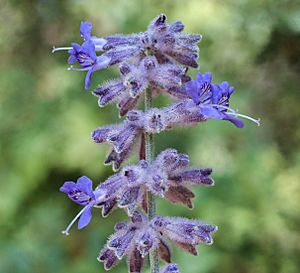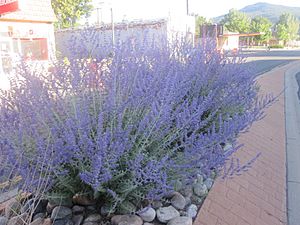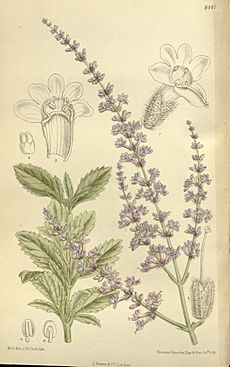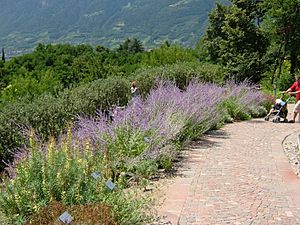Salvia yangii facts for kids
Quick facts for kids Salvia yangii |
|
|---|---|
 |
|
| 'Blue Spire' cultivar | |
| Scientific classification | |
| Genus: |
Salvia
|
| Species: |
yangii
|
| Synonyms | |
|
|
Salvia yangii, often called Russian sage, is a beautiful flowering plant. It used to be known as Perovskia atriplicifolia. Even though it wasn't always part of the Salvia family (which includes many types of sage), it was officially moved into this group in 2017.
Russian sage grows upright, usually reaching about 0.5 to 1.2 meters (1.5 to 4 feet) tall. It has square stems and gray-green leaves that smell special when you crush them. People love this plant most for its pretty flowers. It blooms from mid-summer until late October, showing off blue to violet flowers arranged in big, branched clusters.
This plant originally comes from the dry grasslands and hills of southwestern and central Asia. It's very tough and can grow well in many different climates and soil types. Because of this, it has become a popular plant in gardens everywhere. Several types, called cultivars, have been created. They mostly differ in leaf shape and how tall they grow. 'Blue Spire' is the most common type. Russian sage was even named the Perennial Plant Association's Plant of the Year in 1995. The 'Blue Spire' type also won an Award of Garden Merit from the Royal Horticultural Society.
People in its native lands have used Russian sage in traditional medicine for a long time to help with different health issues. Its flowers can be added to salads or crushed to make dyes. Scientists are also looking into whether it can help clean up polluted soil.
Contents
What Russian Sage Looks Like
Russian sage is a deciduous perennial subshrub. This means it's a small, woody plant that lives for many years and loses its leaves in winter. It often looks like a much bigger version of lavender. Many branches grow from its rootstalk, reaching heights of 0.5 to 1.2 meters (1.5 to 4 feet). Some plants can even grow up to 1.5 meters (5 feet) tall. A mature plant can spread out 0.6 to 1.2 meters (2 to 4 feet) wide. Its stiff stems are square and covered in tiny, star-shaped hairs and oil droplets. These hairs make the stems look silvery, especially in autumn.
Leaves and Scent
The gray-green leaves grow in pairs opposite each other on the stem. They are usually 3 to 5 centimeters (1 to 2 inches) long and 0.8 to 2 centimeters (0.3 to 0.8 inches) wide. The leaves can be rounded or shaped like a lance. Their edges are deeply cut, sometimes wavy or sharp-toothed. Even on the same plant, leaf shapes can vary a lot. Leaves near the top of the branches might turn into small leaf-like structures called bracts. The leaves smell very nice, especially when crushed. People describe the smell as like sage, a mix of sage and lavender, or even like turpentine.
Flowers and Fruit
Russian sage can bloom for a long time, from June through October. The flowers grow in large, showy clusters called panicles, which can be 30 to 38 centimeters (12 to 15 inches) long. Each branch of the cluster has individual flowers arranged in pairs. Each flower has a purple, fuzzy outer part called a calyx, about 4 millimeters (0.16 inches) long. The blue or violet-blue petals form a tube shape, about 1 centimeter (0.4 inches) long. The style (part of the flower's reproductive organ) usually sticks out beyond the flower's tube. From a distance, the flowers can look like a "fine haze or fog."
The fruits appear about a month after the flowers. They are small, dark brown, oval-shaped nutlets, about 2 by 1 millimeter (0.08 by 0.04 inches).
Where Russian Sage Grows
Russian sage is found across a wide area in Asia. It grows naturally in western China, northwestern India, Pakistan, Afghanistan, Iran, Turkey, and parts of eastern Europe. You can find it in dry grasslands, on hillsides, and at high elevations in mountains, including the Himalayas. It has been seen as high as 3,000 meters (10,000 feet) in the Karakoram mountains. In some areas, it grows with a specific type of grass and can show that the soil has low levels of certain minerals. The tough places where Russian sage grows are similar to the dry sagebrush areas in North America.
Growing Russian Sage
When Russian sage was first brought to the United Kingdom in 1904, a gardener named William Robinson loved it right away. He said it was "worth a place in the choicest garden for its graceful habit and long season of beauty." By the late 1980s and early 1990s, Russian sage became very popular. In 1995, it was chosen as the Perennial Plant Association's Plant of the Year. The 'Blue Spire' type has also won the Royal Horticultural Society’s Award of Garden Merit.
Planting and Care
Russian sage is a perennial plant that can grow in many different conditions. It likes full sun. If planted in too much shade, it might spread out or flop over. You can help control this by pinching off young shoots or by planting it near other strong plants for support. Flowers only grow on new branches. To get the best growth and flowers, trim the plants to 15 to 61 centimeters (6 to 24 inches) in early spring.
This plant can handle both hot and cold weather. In North America, it grows in United States Department of Agriculture hardiness zones three through nine. This means it can survive in many parts of the U.S. and Canada. In very cold areas, it might need extra protection in winter. In the UK, it can handle temperatures as low as -10 to -5 degrees Celsius (14 to 23 degrees Fahrenheit).
Russian sage also grows well in different types of soil, like sandy, chalky, or loamy soil. It can even grow in heavy clay soil if it drains well. It can handle a wide range of soil acidity and even salty conditions near the ocean. Its deep taproot makes it very good at surviving dry periods. This is why it's often used in xeriscaping, which is landscaping that uses less water. Giving it too much water or fertilizer can harm its roots. Luckily, Russian sage usually doesn't get many plant diseases. Deer and rabbits also tend to leave it alone, which is a bonus for gardeners!
Using Russian Sage in Gardens

Gardeners love Russian sage for its beauty and usefulness. It's often planted as a special feature, like an "island" in a lawn. It can also fill in spaces in larger garden designs or make natural areas look even better. Some experts say planting groups of three plants looks best. It can also be grown in containers. One thing to watch out for is that it can spread through its roots beyond where you first planted it.
Russian sage attracts bees, hummingbirds, and butterflies. It adds lovely color to gardens with its blue flowers in late summer and the silvery look of its stems in winter.
How Russian Sage Grows and Spreads
Russian sage is often grown from cuttings. Since its woody base is hard to divide, new plants are usually started from soft shoots taken in late spring. Cuttings taken in mid-to-late summer also work. You can also grow the plant from seeds. However, seeds need to be exposed to cold for 30 to 160 days to sprout. Plants grown from seed might not have the exact same features as the named types (cultivars).
Some plants in the Lamiaceae family can spread too much and become invasive. Some gardening guides suggest being careful when planting Russian sage near wild areas because it could spread. However, it is not yet considered an invasive plant. In fact, it has been suggested as a good replacement for other invasive plants like purple loosestrife.
Other Uses
Russian sage has been used in traditional medicine for a long time.
In some parts of Afghanistan and Pakistan, including Kashmir, people eat its flowers in salads because they have a sweet taste. The flowers can also be crushed to make a blue color for cosmetics or to dye textiles. Scientists are also studying Russian sage for its potential to clean up polluted soil. This is because it grows fast, can handle tough conditions, and can take in harmful metals from the soil.
The plant's essential oil can also act as a natural biopesticide against certain beetles and ants.
See also
 In Spanish: Salvia rusa para niños
In Spanish: Salvia rusa para niños




